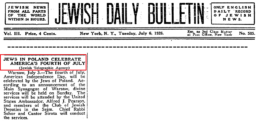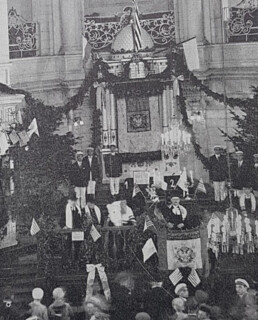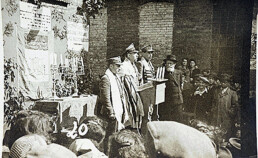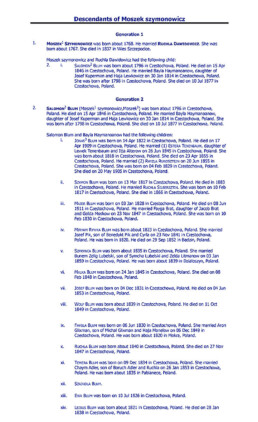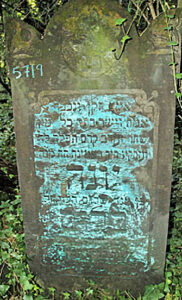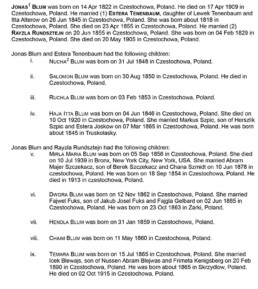The Parochet and Napoleon's Flag
in the Synagogues of Częstochowa
INTRODUCTION
Collections of stories and family gossip often open up new directions for exploring a family’s roots.
One afternoon, while talking with my cousin Matt Shakter and updating the Szczekacz family branch, Matt said:
“I have a two hundred year old story to tell you. In our family, the story has passed from one generation to the next.
“When Napoleon retreated from Moscow, his military units passed through Częstochowa. Before he left, one of the French officers gave a woman, from our family, a French flag as a souvenir. The woman kept the flag, which was later made into a Parochet, the curtain of the Aron Ha-Kodesh [the ark hold the Torah scrolls], and donated it to the Old Synagogue in memory of a family member. According to the story, the flag-Parochet also appeared on occasions when there were military parades in the city.”
Could this tale of a two-hundred-year-old Parochet be true, or was it just a myth that ran in the family?
My young sister, Ofra, remembered a similar story in Alon Goldman’s newsletter.
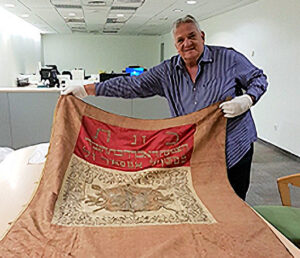 Alon Goldman (pictured left, with the parochet) is the Chairman of the Association of Częstochowa Jews in Israel and Vice-President of the World Society of Częstochowa Jews and their Descendants. He is closely involved in the restoration of the Częstochowa Jewish Cemetery and with Jewish cultural and memorial events in Częstochowa. He often travels to Częstochowa and publishes the Częstochowa Association newsletter.
Alon Goldman (pictured left, with the parochet) is the Chairman of the Association of Częstochowa Jews in Israel and Vice-President of the World Society of Częstochowa Jews and their Descendants. He is closely involved in the restoration of the Częstochowa Jewish Cemetery and with Jewish cultural and memorial events in Częstochowa. He often travels to Częstochowa and publishes the Częstochowa Association newsletter.
THE PAROCHET’S HISTORY
1813-1863
Alon Goldman tells of two Polish regimental flags which were sewn to make Parochets for the holy ark housing the Torah scrolls of the Częstochowa Old Synagogue [See note 1 below]. Each Parochet had a embroidered family inscription.
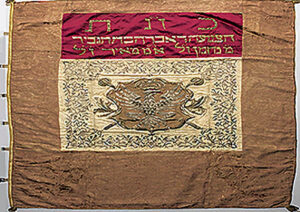 One Parochet was in memory of Dvora daughter of Nachman, wife of Meir.
One Parochet was in memory of Dvora daughter of Nachman, wife of Meir.
The curtain is 137cm long and 115cm wide. The front facade is made of a bright, light-brown damask silk with a white flag at the centre. The flag has an embroidery of a shield, an eagle, with spread wings and legs, and a crown. Above the flag, there is a rectangular piece of satin, embroidered with the Hebrew dedication:
כ ז״נ ת
הצנועה דאברהבתהגביר
מ׳ נחמן ז״ל אמ מאיר ז״ל
The details in Hebrew:
כתר זה נדבת תורה
הצנועה של דאברה בת הגביר
נחמן ז״ל אשת מאיר ז״ל
“Crown of Torah
This is a donation of the modest Dobra, daughter of the opulent Mr. Nachman z”l[See Note 2 below]
wife of Mr. Meir’s z”l”
Alon Goldman mentions a second flag that was made into a Parochet, in memory of Chaya, wife of Yosef Heiman.
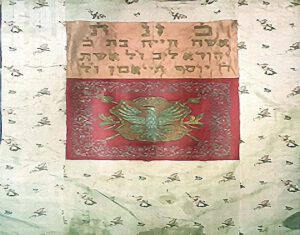
The second Parochet is 185 cm long and 130 cm wide.
An eagle with its wings and legs spread and a crown on its head is embroidered on a shield at the center of the red canvas.
The canvas on the other side of the Parochet is damaged.
The Hebrew inscription is:
כ‘ ז”נ ת
אשה חייה בת כ
יהודא ליב ז”ל אשת
ר’ יוסף הייאמן ז”ל
The details in Hebrew are:
כתר זה נדבת תורה
אשה חייה בת כבוד
יהודא ליב ז”ל אשת
ר’בי יוסף הייאמן ז”ל
“Chaya daughter of Yehuda Leib z”l the wife of Yosef Heiman”
The identities of the two women mentioned on the Parochets remain a mystery, because no surnames are known for them, for their husbands or for their fathers. Alon Goldman believes that the Parochets were donated to the synagogues by relatives from the same family. He quotes evidence from an article from the Częstochowa edition of Gazeta Wybora, dated 5th May 2016, “Napoleonic Banners in the Synagogue in Częstochowa” by Jarosław Sobokowski:
According to Sobokowski, during Napoleon’s retreat from Moscow in the winter of 1813, Napoleon’s starving troops arrived in Częstochowa around 24th-25th March. Several of the officers rested at Meir Blum’s Red House Inn in the Stary Rynek [Old Market Square], when a siren warned of the approach of the Russian enemy. The French, followed by the Poles, hastily fled the city and left behind two flags. Meir Blum, the innkeeper, managed to hide these flags, symbols of independent Poland, from the Russian troops.
When the two flags were made into the Parochets, one was inscribed to Meir Blum’s wife, the daughter of Nachman, and the second to the mother of his daughter-in-law, Chaja, wife of Josef Hajman.
My cousin Matt’s story told of a French flag given to the Szczekacz family, while Alon Goldman refers to a Polish flag dedicated to women from Blum family. Abram Majer Szczekacz, Matt’s grandfather, married a Mirla Blum. Could the Polish flag, turned Parochet, be the French flag from Matt’s family story? Is Mirla Blum, who married Abram Majer Szczekacz on 10th June 1878 in Częstochowa, related to Meir Blum, the 1813 innkeeper? Can we match people on our family tree with the names on the inscriptions on the two Parochets?
The Polish flags, turned into Parochets, hidden for half a century (1813-1863) by the family of Meir Blum the innkeeper, reappear in the Częstochowa Old Synagogue during the brief Polish uprising against Russia in 1863. According to Jarosław Sobokowski, after the uprising failed, the Parochets were hidden again, for fifty-three years, by a prominent, but unnamed family, for fear of looting by the Russian occupier.
The same story about the flags appears in Vila Orbach’s book, “The History of the Jews of Częstochowa” [See Note 3 below].
A photo [See Note 4 below] and a brief sentence about the flags-Parochets appear in the “The Jews in Częstochowa to World War I” by Dr. Yaakov Shatzki.
1916
Sobokowski continues:
The flags were taken out of their hidden place on 3rd May 1916. The celebration, on that day, was exceptional in Częstochowa. The city, occupied for almost two years by the German army, did not seem to remember war and enslavement. White and red banners, the colors of the Polish flag, were raised in the city and “Goniec Częstochowski”, the most important local Częstochowa newspaper at the time, advised how to sew a Polish flag from two pieces of white and red canvas.
The Jews also celebrated 3rd May 1916 in the synagogue. They had the two Polish banners that have been already turned into Parochets. “Goniec Częstochowski” notices this and describes the uniqueness of these banners. [See Note 5 below] The newspaper was translated [See Note 6 below] for the essay by Jan Gronski.
1926
Both Parochets can be seen in the New Synagogue [See Note 7 below], which was built in 1893 on the corner of ul. Wilsona (formerly ul. Aleksandrowska) and ul. Garibaldiego. The Parochets were on loan to the New Synagogue for the celebration of the 150th anniversary of USA independence.
In 1926, the United States marked the sesquicentennial of the signing of the Declaration of Independence with a major celebration. So, too, did Poland which had, itself, only regained its independence in 1918, with significant U.S. support. Polish efforts to celebrate U.S. independence culminated in October 1926 with the presentation, to President Calvin Coolidge, of over 111 volumes of greetings from the people of Poland and a gold medal [See Note 8 below]. The gift was called “A Polish Declaration of Admiration and Friendship for the United States of America”. These volumes consisted of a declaration of admiration signed by an estimated 5,500,000 Polish citizens, representing more than one- sixth of the total population of Poland in 1926 [See Note 9 below].
The Jewish community, together with Polish nation, celebrated the 150th anniversary of United States [See Note 10 below] Independence.
The Jewish Daily Bulletin announced the 150th United States Independence Day celebrations:
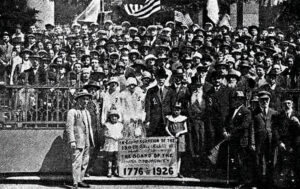
Above: Following the 150th United States Independence Day celebrations, Rabbi Nahum Asz stands next to the New Synagogue’s gate. Next to him are S. Goldsztajn, Ch. Weksler, M. Asz, M. Sudowicz, D. Filipowicz, J. S. Koblenz, B. Bocian, J. Kopin, A. Sigman and guests from the United States.
Left: Cantor Fiszel leading the prayer service in the Częstochowa New Synagogue.
1939-1946
On 3rd September 1939, the Germans occupied Częstochowa.
On 25th September 1939, the Germans, aided by a Polish mob, ravaged the Old Synagogue. In 1943, it was finally destroyed by the Nazis during the liquidation of the “Small Ghetto”.
The New Synagogue was set on fire by German military policemen, assisted by their Volksdeutsch henchmen, on Christmas Day, 25th December 1939.
It was thought that the Parochets shared the fate of the synagogues [See Note 11 below] and the tragic fate of the Jewish people and that they disappeared in the rubble of the temples.
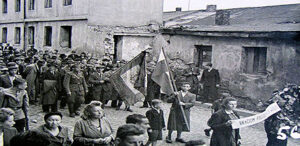 After the liberation of Częstochowa, however, the Parochets were miraculously recovered. A photograph (left) by Lew Kusznir, from 1945 or 1946, shows one Parochet carried as a flag in the forefront of a march along ul. Spadkowa and ul. Kozia in Częstochowa. The march was to honour the exhumation of the bodies of Jewish victims and their burial in the Jewish cemetery. [See Note 12 below]
After the liberation of Częstochowa, however, the Parochets were miraculously recovered. A photograph (left) by Lew Kusznir, from 1945 or 1946, shows one Parochet carried as a flag in the forefront of a march along ul. Spadkowa and ul. Kozia in Częstochowa. The march was to honour the exhumation of the bodies of Jewish victims and their burial in the Jewish cemetery. [See Note 12 below]
Sobokowski quotes historian Wiesław Paszkowski, a specialist in Jewish history from the Centre for Documentation of the History of Częstochowa:
“I have photos from the ceremony that takes place after 1945, where we can clearly see one of the Napoleonic banners that were in the hands of Jews before the war.”
Asked about the banner, the Wiesław Paszkowski replied, “I am almost certain … that this particular banner went to the Israel Museum in Jerusalem… Perhaps it was with the wave of emigrants, who were allowed to take Judaica with them in the late 1960s”.
(Pic right) After the Holocaust, a memorial service for the victims of the Nazis, with the participation of the Polish Army’s Chief Rabbi, Dr. Dawid Kahana. [See Note 13 below]
On the right, the man with glasses, is Częstochowa Rabbi, Eliasz Nusyn Wajsler.
The Parochet, in memory of Dvorah daughter of Nachman z”l and wife of Meir z”l, is hanging on the wall.
The FATE OF THE PAROCHETS – ALON GOLDMAN’S STORY
On a visit to Częstochowa, Alon Goldman became intrigued by the mystery of what happened to the artifacts from the Old Synagogue. Vila Orbach’s book about the Jews of Częstochowa reinforced his belief that the Parochets may have survived.
In November 2018, Alon announced that the two Parochets had been found – one in Jerusalem and the other in Melbourne, Australia.
Alon’s research led him to the Israel Museum in Jerusalem, where he understood that the small Parochet (in memory of Dwora, Meir’s wife) had been on open display in 1985 and 1988, following which it was and was now stored in the museum’s archive. After donning gloves, he held the precious Parochet in his hands for the first time.
The museum had received the Parochet as a gift from Tzvi Szpalten [See Note 14 below], a Holocaust survivor, who lived in Tel Aviv. The date of the gift is not recorded. The Parochet may have arrived in Israel, during the emigration of Jews from Poland in 1968.
Alon Goldman continues:
“The Parochet in Melbourne, Australia, remained in the care of the Faigenblat family. When I met Mark Faigenblat in Tel Aviv, he told me that the man holding the flag, in the photo of the march in 1945 or 1946 in Częstochowa (above), was his father. When his father immigrated from Częstochowa to Australia, in 1949, he took the Parochet with him. How the Parochet turned out to be in his father’s hands after the war remains a mystery.
“Mark and his brother Len had decided to donate the Parochet to the Jewish Holocaust Museum in Melbourne, Australia. Dr. Anna Hirsch, Senior Archivist of the Museum, informed me that the Museum plans to open a permanent exhibition in 2021, which will focus on the story of the Jewish community of Częstochowa and the Treblinka death camp. The Parochet from the Israel Museum will be on loan.
“The exhibition will bring together the two Torah Parochets from Częstochowa under one roof after more than eighty years.”
THE BLUM FAMILY STORY
Are the Polish flags-Parochets the same as the French flag-Parochet from Matt’s story? The answer to this question is more likely yes.
Is Miriam Blum, who married Abram Majer Szczekacz on 10th June 10 1878 in Częstochowa, related to Meir Blum, the innkeeper from 1813?
The current available Polish records do not include birth, marriage or death records regarding Meir Blum, the innkeeper, and his extended family. However, while it is difficult to determine relationships conclusively, we can match names from the family tree to those inscribed on the flags. As you will see, for some family members, we found their graves in the Częstochowa Jewish cemetery. We thank the Reut School for their Gidonim Project [See Note 15 below].
In the records of CRARG [See Note 16 below], Salomon Blum (circa 1796-1846) is the first person known to bear the surname Blum. Salomon was from Szczepocice [See Note 17 below], Poland, a small town with few inhabitants, located near Częstochowa. His parents had patronymic names instead of surnames – Moszek Szymonowicz and Ruchla Dawidowicz. Salomon Blum was an innkeeper. He and his wife, Bayla Hajman, had fourteen children. One son, Jonas Blum (1822-1909), was also an innkeeper.
According to Jewish customs in those days, parents often named their children after their own parents, siblings or other close relatives. Our data shows that, when Salomon had a son born in 1828, he named him Meir. Was he named after Meir Blum, the innkeeper from our story?
(1) The inscription on the small Parochet from the Israel Museum reads:
Dvorah daughter of Mr. Nachman z”l, wife of Mr. Meir
Salomon’s son, Meir Blum (1828-1911), married Fagla Brat (1830-?) in 1847 – they had a daughter, Dwora, born in 1869. Was she named after Dwora, daughter of Nachman and wife to Meir the innkeeper in 1813, from the Parochet’s inscription?
The names Dwora daughter of Nachman, wife of Meir, and the brick house in Częstochowa’s Market Square appear also in an article by Dr. hab Janusz Spyra.
The article lists the oldest names of the Jewish families in Częstochowa, but does not provide a full genealogical coverage of them. Spyra mentions that sources are not always accurate due to a lack of certificates from prior to 1808, the great mobility of Jews and the practice of using different first names and surnames, which hinders identification.
But Spyra does tell of a family of Nachman, his daughter, Dwora, and his son-in-law Meir who, like Salomon Blum, were residents of Szczepocice.
Were Nachman and his extended family the actors in our flag story? Were they related to Salomon Blum? Our detective work seems to indicate that the answer to this is yes. A detailed, more complete proof may only be possible once more CRARG records become available, or through research in Archiwum Państwowe w Częstochowie – the State Archives in Częstochowa.
(2) The inscription on the Melbourne Parochet reads:
“Chaya daughter of Yehuda Leib z”l the wife of Yosef Heiman”
Current CRARG records lead me to believe that the second Parochet is in memory of the mother of Salomon Blum’s wife. Salomon Blum married Bayla Hajman, daughter of Josef and Chaja.
Another confusing data point can be added here. Viewing the records relating to the births, marriages and deaths of Bayla’s children, her husband Salomon Blum’s death record, the record of her second marriage folloowing the death of her husband Salomon and her own death record, we find that she appears with different maiden names – Bayla Hayman, Bayla Kaperman and Barbara Kaperman. Her father’s name, in the Marriage Banns [See Note 20 below], is Jaska Jachymowicz, where Josef might easily be Jaska, but Jachimowicz? Maybe a partonomic name.
Searching carefully the Hayman (Heiman) available Częstochowa vital records, we can find the following records:
- Bayla’s Banns’ records include a reference to her parents. There are two Banns: the first on 23rd Jan 1814 and the second 30th Jan 1814. They took place in Szczepocice and Częstochowa Stara. The text in both banns is the same. The part of the record related to the bride states:
- Bride: Bayla Jaskiewiczówna of Stara Częstochowa
- Bride’s Father: Jaska Jachymowicz, hardware peddler (Jaska easily stands for Jósef)
- Bride’s Mother: Hai (?) nee Lewkowicz. (Hai(?) easily stands for Haja)
Again, we see here the inconsistency in Patronymic names.
Bayla, herself, lived a long life and could have commemorated her mother Haj(a) with the second Parochet. We can deduct, from Bayla’s bann, that her mother’s name appears as Haj(?) Lewkowicz. The Lewkowicz surname is a patronymic derived from Lew. The given name Leib was probably derived from Lew or Lev (See the Dictionary of Ashkenazic Given Names by Alexander Beider). This assumption matches the inscription words “Chaya daughter of Yehuda Leib z”l”
- Josef Kuperman’s death record:
- He died 14th July 1831 in Częstochowa at the age of forty-five.
- His wife’s name was Haja (Chaja) and he left a daughter Bayla.
- Among the witnesses listed in the death record is Salomon Blum from Częstochowa.
Josef Kuperman’s death record includes a comment that he left a daughter Bayla. The comment might be a hint she was the only living child.
Let us now look at Bayla’s and Salomon’s descendants. We can assume that Bayla named her son, Josef, who was born on 4th Dec 1831, after her father, who died several months before, on 14th July 1831 [See Note 21 below].
Lately I found a reinforcement to these assumption in an article by Dariusz Złotkowski [See Note 22 below] about Jewish wills from Częstochowa. Złotkowski discusses ten Jewish wills. One of them is that of Haja Kuperman nee Lewkowicz from Częstochowa. Josef Heiman husband of Chaya, mentioned above, was recorded also as Yosef Kuperman.
A quotation, from the will, reinforces the argument that Josef Heiman is the same as Josef Kuperman:
- The quotation includes the name of his brother – Berek Hayman.
- The quotation lists Haja and Josef Hayman – Kuperman’s children and grandchildren. The list matches exactly the list of the living children in our Blum’s family tree [See Note 23 below].
- The family’s property was an inn.
A good illustration of a rather prosperous testator [See Note 24 below] is Haya (Haja) nee Lewkowicz, the widow of Jozef Kuperman’s [Kupferman] widow [See Note 25 below]. Her last will was drawn up, on 23rd November 1831, at the office of notary public of Częstochowa poviat, Ignacy Budrewicz. She was a Częstochowa resident and lived at the “Biadacz austeria [inn]”. The only surviving child of her thirty-six- year-long marriage was a daughter, Bayla, Mrs. Kalenion Blum. The rest of her children died early. The grandsons, after that daughter, were: 1) Szymon, 2) Lewek, 3) Jonas, 4) Majer, 5) Jozef, her granddaughters were: 1) Maria and 2) Faygla.
The real property of Haya consisted of, as she recounted it, a half of the inn, located in Częstochowa, “nicknamed Biadacz”. It had been set up jointly by the Kupermans. The other half belonged to Bayla Blum, who had inherited it from her father. As for the non-fixed assets, Haya just mentioned vaguely “various valuables, being silver, gold, jewels, pearls, in copper, tin, domestic articles, as well as ready money with a major part of debts”, meaning various people, who owed her money. She bequeathed her entire property to her seven grandchildren in even shares, except for the eldest, crippled Szymon, who was to have it increased by 15 per cent.
The testator’s wish was that her half of the inn “is never sold to any stranger”. She also wanted it to be leased until her grandchildren would be of age, thereupon it should remain in the hands of a sole proprietor, who would pay off his or her siblings. She made a point of explaining why her daughter Bayla was left with current income only, while the bulk of the inheritance would go to the grandchildren. The reason for this was that her daughter “with her husband, and my son-in-law, have not been managing well and have already squandered a considerable part of their fortune, thus the part I am in possession now would be in danger of being squandered too.”
The data in the last quotation almost closes the circle of the people behind the names on the Parochets and our family tree.
It is interesting to examine closely the naming of children and grandchildren in the first three generations of the Blum family. We have already examined Meir Blum [See Note 26 below] (1828-1911), the son of Salomon and his granddaughter, Dwora, born in 1862. Let us now also look at Jonas Blum [See Note 27 below], son of Salomon Blum and Bayla Hayman, is the father of Mirla Maria Blum, wife of Abraham Meir Szczekacz.
The last couple are Matt Shakter’s grandparents. To remind you, Matt Shakter, triggered the research into the link between the Alon Goldman’s story about the Parochets and our family.
Additional data is required to solve the mystery in the family tree between the generation of Majer Blum, the 1813 innkeeper, his wife Dwora in the Parochets’ story and the generation of Salomon Blum and his wife Bayla Hayman. Jarosław Sobkowski, in his article, does not state the source for the connection between the two families. This source might help us solve the mystery.
NOTES:
1 The Old Synagogue, which was located on the corner of ul. Nadrzeczna 32 and ul Mirowskat, was the first synagogue built in Częstochowa. The exact date of its construction in the 17th century is unknown.
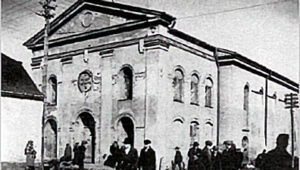 |
“In the years 1928-29, Perec Willenberg undertook the design and renovation of the Old Synagogue in Częstochowa. His passion was to create a Jewish style in painting. He created works using stylised Hebrew characters, which he applied to the multi-coloured ceilings of synagogues in Częstochowa and in Piotrków Trybunalski. He also created stained-glass windows and flooring in this style.” – “Perec Willenberg” by his son Samuel Willenberg
Pics right: photographs of Perec Willenberg and his art in the Częstochowa Old Synagogue: |
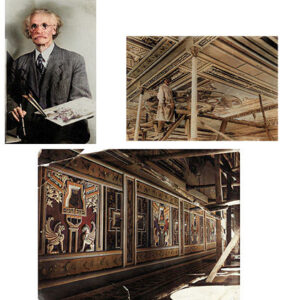 |
2 z”l – “may his memory be blessed”
3 About the existence of the flags – “History of the Jews of Częstochowa”, Vila Orbach, published by the Association of Częstochowa Jews in Israel, Tel Aviv, 2000, pp. 31-32.
4 About the existence flags: The Book of Częstochowa (Częstochowa, Poland), Chapter about “Jewish Częstochowa and its History”
5 “Goniec Częstochowski”, 7th May, 1916, p.1, “ Echa 3 Maja” (See translation below)
6 “Echoes of 3rd May”
In the Synagogue
On May 2nd at noon, in the presence of the Municipal Authority, the City Council, representatives of important institutions and the press, with the participation of Rabbi Asz, Rabbi Isajewicz, Cantor Fiszel and members of the Jewish Community Council Messrs. Markus Henig, Henryk Markusfeld, Fabj. Zorski, Jak Helman, L. Tempel, Dr. Wladysław Zachs, St. B. Helman, Iz. Freund, St. Weinberg and eng. Gustaw Kohn a service was held in the New Synagogue within the city walls. The temple was flooded with lights, flowers, greenery and white- red decorations. The most eye-attracting elements were the previously mentioned two Polish flags, with the white Polish Eagle elaborately embroidered with gold and silver on them.
Polish Eagles
The story of these objects is quite peculiar. During Napoleon’s retreat from Moscow, i.e, 104 years ago, officers were quartered, at the time, in our town’s only inn, located in the Stary Rynek, “Red House”, Blum’s Inn. When the alarm of the enemy approaching was raised, the Frenchmen and, together with them, the Poles abandoned the town leaving behind the two banners. The innkeeper hid them from the Russians and harbored them for a long time until, during the 1868 uprising, they appeared as “puroches”, i.e., scroll curtains in the Old Synagogue at the corner of ul, Prosta and ul. Garncarska. Hebrew words stitched on the silk testified that the two-sided flag was donated by Dobra, daughter of Nachman and wife of Majer Blum and that the one-sided one was donated by Chaja wife of Jozef Hejman. Both women belonged to the Blum family, one as a daughter and the other one as a daughter-in-law. They harbored these precious objects during the times when Cossacks and the Russian Army were searching the throughout the Kingdom until during the fiercest battles of the 1868 uprising:
“Boże coś Polskę”
After the suppression of the uprising, the flags were hidden by one of the most notable Jewish families until, after sixty-eight years, on 3rd May 1916, they again saw the light of the day. It seemed that the banners’ eagles awoke again and with their wings aflutter, gazing towards the approaching dawn of freedom. And again, after the service, Polish anthems “Boże coś Polskę” and “ Z dymem pożarów” were sung under the direction of Mr. M. Steinfeld
7 The New Synagogue was built, in 1893, on the corner of ul. Wilsona (formerly ul. Aleksandrowska) and ul. Garibaldiego
8 Poland Celebrates the Sesquicentennial of U.S. Independence, 1926: Part I https://text-message.blogs.archives.gov/2017/07/18/poland-celebrates-the-sesquicentennial-of-u-s-independence-1926-part-i/
9 Poland Celebrates the Sesquicentennial of U.S. Independence, 1926: Part II https://text-message.blogs.archives.gov/2017/07/19/poland-celebrates-the-sesquicentennial-of-u-s-independence-1926-part-ii/
10 The Book of Częstochowa (Częstochowa, Poland), Chapter about “The Jewish Community and the Municipal Institutions by David Koniecpoler”
11 The Old Synagogue was ravaged by the Germans, aided by a Polish mob, on 25th September 1939. In 1943,the Nazis completely destroyed it during the liquidation of the “Small Ghetto”.
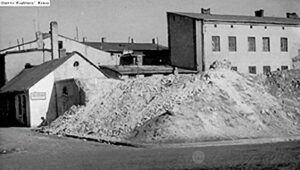 The New Synagogue was set on fire by German military policemen, assisted by their Volksdeutsch henchman on Christmas Day, 25th December 1939.
The New Synagogue was set on fire by German military policemen, assisted by their Volksdeutsch henchman on Christmas Day, 25th December 1939.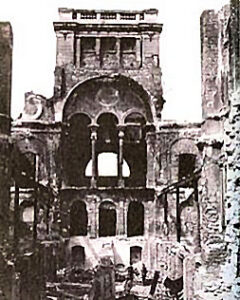
12 The USHMM has a very similar photo .
January 1945, Czestochowa. Photo Credit USHMM
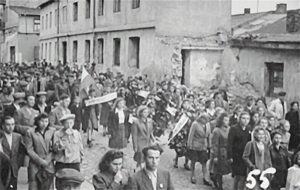 Jewish survivors in Częstochowa march along ul. Spadkowa-Kozia in protest against the way Jewish victims of German actions in the small ghetto were buried in mass graves filled with lime.Jewish survivors in Czestochowa march along Spadkowa-Kozia Street in protest against the way Jewish victims of German actions in the small ghetto were buried in mass graves filled with lime. Hela and Jack Shipper are pictured in the foreground in the centre. As a result of the protest, the bodies were exhumed and buried in the Jewish cemetery in Częstochowa. Among the victims were the donor’s brother, Leib Shipper, his sister, Yentel (Shipper) Owieczko, and her daughter, Hela.
Jewish survivors in Częstochowa march along ul. Spadkowa-Kozia in protest against the way Jewish victims of German actions in the small ghetto were buried in mass graves filled with lime.Jewish survivors in Czestochowa march along Spadkowa-Kozia Street in protest against the way Jewish victims of German actions in the small ghetto were buried in mass graves filled with lime. Hela and Jack Shipper are pictured in the foreground in the centre. As a result of the protest, the bodies were exhumed and buried in the Jewish cemetery in Częstochowa. Among the victims were the donor’s brother, Leib Shipper, his sister, Yentel (Shipper) Owieczko, and her daughter, Hela.
13 Polish Army’s Chief Rabbi, Dr. Dawid Kahana – Czestochowa Yizkor Book page 358
14 Zvi Szpalten was born in Częstochowa, in 1892, to Shraga Fajwel and Lea Liberman. He married Henia Fiszman. The couple lived in Czestochowa with their three boys – Solomon (b.1923), Szraga Fajwel (b.1927), named after Tzvi’s father and. Eliezer (b.1930), named after Tzvi’s grandfather. On 1st October 1942, Henia and the three boys were fatally shot in Częstochowa. Zvi was in HASAG Częstochowianka during the war – he survived the Holocaust and immigrated to Israel. Zvi remarried in Israel to Malka Landau nee Szwarcbaum. Before the Holocaust, Malka was married to Icek Szlomo Landau – they had a son Henryk Landau. Icek Szlomo Landau and their son were murdered by the Nazis. Zvi was industrialist and was active in Częstochowa communal life. In Israel, Zvi joined the publishing committee for the publication of a Częstochowa memorial book.The Częstochowa Yizkor Book contains a chapter, written by him,.entitled Rescue Committee for Refugees from Germany by Tzvi. Szpalten, F. Szmulewicz. Another chapter tells about his activities, Industry in Częstochowa– Its Creation and Development by Jakob Lewitt. A tombstone in memory of the descendants of Zvi’s parents, Fajwel Szpalten and Leja Liberman, and their family stands in Częstochowa Cemetery. Zvi Szpalten died on 1st December 1982 in Holon, Tel Aviv. His second wife, Malka, died on 8th December 1990 in Holon, Tel Aviv. We do not know how did Tzvi Szpalten obtained the small Parochet and when he donated it to Israel Museum in Jerusalem.
15 The Gidonim Project – www.gidonim.com. For many years, historian Wiesław Paszkowski, of the Częstochowa Museum Documentation Centre, has studied the history of the cemetery and its graves. In 2012, he published the first volume of the Polish guide to the Jewish Cemetery of Częstochowa.The Gidonim Project is a unique undertaking by students of Reut High School in Jerusalem, under the leadership of the teacher Dina Weiner. The students travel to Poland every year since 2004, to restore, photograph and document graves in Jewish cemeteries in Poland. Between the years 2008 and 2016, Alon Goldman, Chairman of the Association of Częstochowa Jews in Israel, helped to raise funds to renovate the Częstochowa Jewish Cemetery. In 2018, Alon Goldman integrated the data from the mapping conducted by the historian Wiesław Paszkowski with the mapping created by the Gidonim and the results of the work were uploaded to the Gidonim website, which can be searched in HEBREW or ENGLISH.
16 Czestochowa-Radomsko Area Research Group – https://www.crarg.org/
17 Salomon Blum was from a small place, Szczepocice. The place does not appear in the book Where Once We Walked, A Guide to the Jewish Communities Destroyed in the Holocaust. It appears twice in Wikipedia:
- Szczepocice Prywatne is a village in the administrative district of Gmina Radomsko, within Radomsko County, Łódź Province, in central Poland.It lies approximately 10 kilometres south-west of Radomsko and 86 km south of the regional capital Łódź.
- Szczepocice Rządoweis a village in the administrative district of Gmina Radomsko, within Radomsko County, Łódź Province, in central Poland. It lies approximately 9 kilometres south-west of Radomsko and 85 km south of the regional capital Łódź.
18 Częstochowa Marriage Record of Abram Majer Szczekacz and Mirla Blum (Literal translation of record #26 film 1659507):
In Częstochowa, town twenty-first June / third July, eighteen seventy-eight year at six o’clock afternoon [21 Jun / 3 Jul 1878 at 6:00 PM]. It was affirmed that, in the presence of witnesses Aba Pelc, teacher fifty-five years old, and Lajzer Besser, servant forty-nine years old, both resident in Częstochowa, a religious marriage between Abram Majer Szczekacz, twenty-three years old born Częstochowa, son of Berek trader and Hana nee Szmidt, living with parents in Częstochowa, and Mirla Blum, unmarried, born in Częstochowa, daughter of Jonas trader and Marianna nee Rundsztejn, twenty-one years old, living with parents in Częstochowa. The marriage was preceded by three announcements in the local synagogue on twenty-fifth May, third and eighth June current year as confirmed by present certificates. The newlyweds declare that they do not have a marriage [pre-]agreement. The religious marriage ceremony was performed by Dawid Weksler, acting as Rabbi of Częstochowa District. This record was read all present and signed, with the exception of Lajzer Besser and the newlyweds – they were declared illiterate.
19 Abram Majer died in 1913 – his grave stands in Częstochowa cemetery:
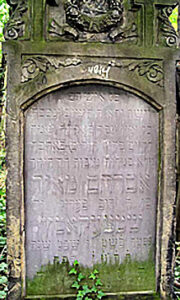 |
First Name: Abraham Meir Father: Dov Berl Spouse: Miriam Blum Last Name: Szczekacz Date of Death: 15.1.1913 Remarks: Brothers next to each other. Lot No. 4, Row No. 8, Position in Row 14, Tombstone ID: 4814, ID according to Paszkowski: 843 11 H. ID According to Yaari: 2070 |
20 “Marriage banns” are announcements of a marriage, usually made at weekly intervals. Normally, there are three of these announcements, made at the synagogue of the groom and the synagogue of the bride.
21 Josef Kuperman – death record – Częstochowa Births, Marriages, Deaths 1826-84: 1831, Death record No.31 Registration Date: 3rd August 1831 film 875326: Death Date: 14th July 1831, in Częstochowa. Deceased: Josef Kuperman, age 45. His spouse: Haja. Witness 1: Salomon Blum, Częstochowa. Witness 2: Abraham Szacher, 38, hospital worker, Częstochowa. Witness 3: Mojżes Landau, 59; The Deceased left a daughter Bayla.
22 “Jewish Wills from Częstochowa and the Vicinity as Historical Sources for a Study of the Jewish Life in the First Half of the Nineteenth Century”, Dariusz Złotkowski
23 The Blum Family Tree – it is important to note that some of Salomon and Bayla’s children died before the will was written.
24 According to note 56 in the article: Neither the testator’s (Haja Hayman-Kuperman nee Lewkowicz) birth nor death dates have been found in any records at Częstochowa ASC (registry). She did not remarry in the period in question. Her death was not reported either. She might have died of cholera and was buried hastily without proper formalities.
25 According to note 57 in the article: He (Josef Kuperman) died at 65 (according to his death record, he died at age 45), on 14th July 1831, at noon. His demise was reported by Salomon Blum on 3rd August 1831 with witnesses: Jozef Salten(?) age 40, and Mojżesz Landau, 59. The record includes information on the remaining family: his daughter Bayla, Mrs. Salomon Blum, and his wife, Haya. (Częstochowa Births, Marriages, Deaths Records 1826-84)
26 Meir Blum (son of Salomon Blum) Grave(1828-1911):
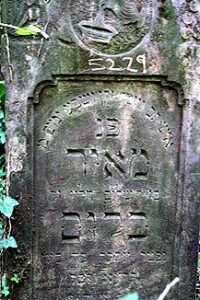 |
Meir Blum Son of Shalom Hallevi Spouse Freida Cohen (Fajgla Brat) Died on 21 June 1911
|
27 Jonas Blum – one of Salomon’s children was Jonas Blum (1822-1909), who was also an innkeeper. Jonas was married twice. His first wife was Estera Tenenbaum (1818-1855), with whom he had three children: Haja Itta, Nucha and Salomon. His second wife was Rayzla Rundsztein (1829-1905), with whom he had five children: Mirla Miriam, Hendla, Chim, Dwora and Temara. Rayzla had been married before to Dawid Blumenfeld (???-1854). Jonas was her second husband. She had a daughter from her first marriage – Chana Blumenfeld.
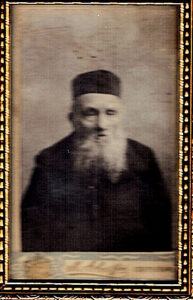
Jonas Blum |
The Grave of Jonas Blum in Czestochowa Cemetery Yona son of Shalom Halevi, married to Reizel Rondshein Death Date: 17 April 1909 Lot No.: 5, Row: No. 7, Position in Row: 19 Tombstone ID:5719 ID according to Paszkowski: 519 11 H ID according to Yaari: 2173 |
Source:
The Webmaster gratefully
acknowledges the author
of this article
RUTH WILNAI
and
ALON GOLDMAN
who was instrumental in arranging for it to appear
on our website.

